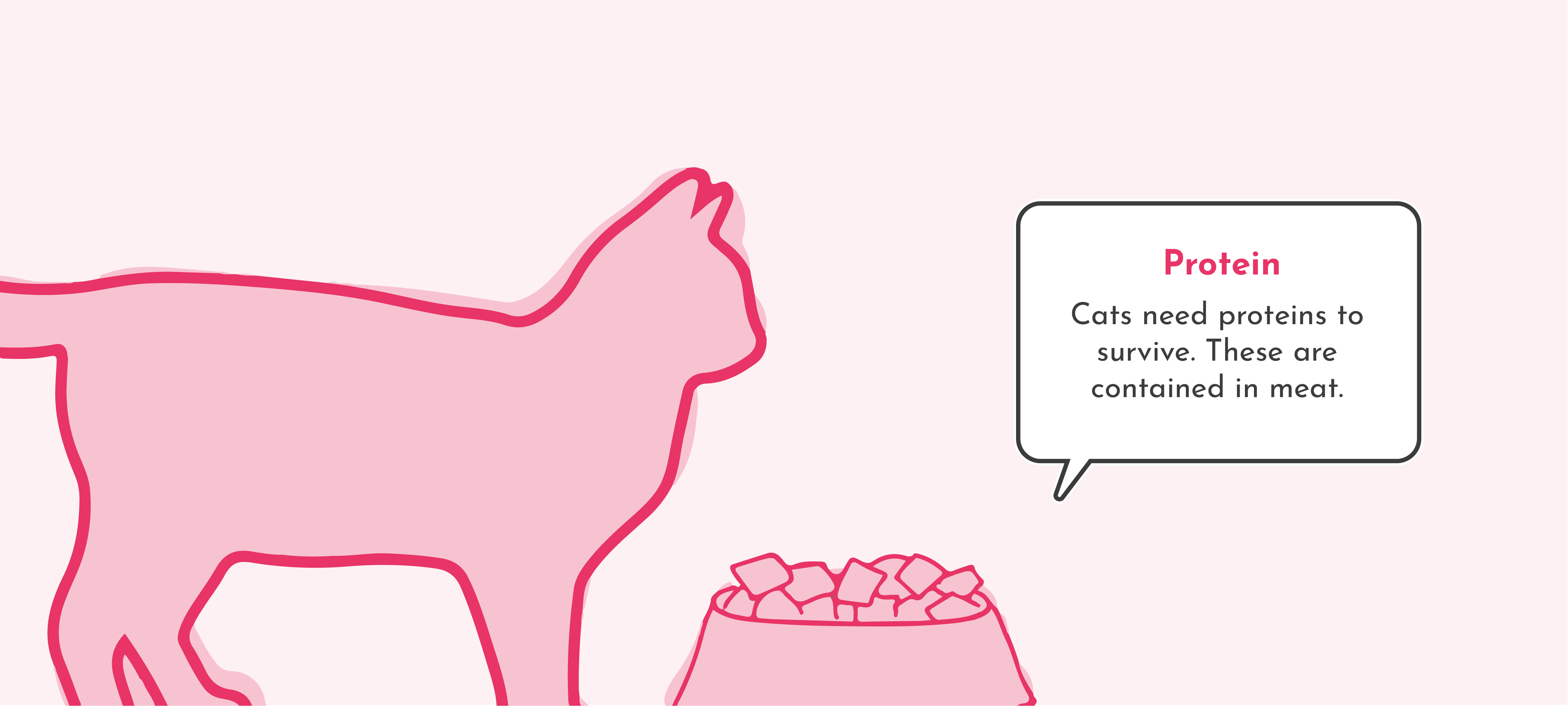Cats need meat
It has been said that cats are just “little dogs”, but that’s not really the case. Cats, unlike dogs, are “obligatory carnivores” – their diet doesn’t just contain meat, it is the sole constituent. Meat contains essential proteins, which are made up of “amino acids”. Amino acids are the smallest building blocks of proteins. Cats gain their energy solely from these amino acids, in contrast to other mammals which can also gain energy from sugar and fats. The metabolism of cats is geared to the utilization of proteins. The enzyme system they employ in digestion to break down proteins is highly active and operates independently of whether they have consumed food. If a cat’s food doesn’t contain enough protein, it will start digesting the protein from its own muscles. The result is muscle loss. Cats are also reliant on consuming enough “essential” amino acids – those that they cannot themselves create. They need to be present in food, whether ready-made or diet food.

Hence, it is important that cats receive adequate meat in their diet. On the other hand, meat is high in phosphates. Healthy cats have no difficulties in excreting excess phosphate in their urine. Chronic kidney disease cats, however, need to significantly reduce their phosphate levels, as phosphate contributes to worsening of chronic kidney disease (CKD) and thus a reduction in survival time. Kidney-friendly diets, therefore, replace meat with plant proteins (mostly wheat gluten), which have significantly lower phosphate levels. However, cats are fussy eaters; they have fine noses for the scent of meat. They don’t like plant protein very much. Protein digestion is also associated with a further problem in CKD cats. Proteins are broken down into their smallest constituents, amino acids, in the gastrointestinal tract. These amino acids are then transformed by intestinal bacteria. It is the essential amino acids, in particular, that give rise to precursors of uraemic toxinsToxic, nitrogen-containing urinary substances responsible for uraemia and kidney damage.... – toxins that need to be excreted via the kidneys. The precursors of these toxins formed by the intestinal bacteria are absorbed and converted into actual uraemic toxins in the liver. From there they reach the kidneys via the blood, where they are filtered out into the urine and thus excreted. High levels of protein in the diet lead to high excretion of these toxins. For cats with healthy kidneys that’s not a problem. Only when the filtration capacity of the kidneys is compromised, as is the case in chronic kidney disease cats, do uraemic toxins remain in the blood. That’s when organ damage occurs. The kidneys are themselves partially responsible. In CKD, uraemic toxins can cause nephronsNephrone sind die Filtereinheiten der Nieren.... to be destroyed and the disease to progress. They are also responsible for many of the clinical symptoms of CKD.
Cats with chronic kidney disease must therefore be fed with a protein-reduced, kidney-friendly diet, in which meat protein is replaced by plant protein to reduce the phosphate content. Such a diet is also low in protein, which lowers uraemic toxin levels, mitigating their effects on the kidneys and clinical symptoms. Cats with kidney disease rarely have a good appetite – on the contrary. Eating poorly or refusing food altogether is a feature of CKD in cats. Since cats are, by their nature, very fussy eaters, switching to a kidney-friendly diet is challenging.
Since 2018, it has been possible to reduce uraemic toxin precursor uptake in the intestine. The cat is given an oral adsorbent, which acts similarly to “oral dialysis”; uraemic toxin precursors are absorbed in the intestines and then excreted in the faeces.
